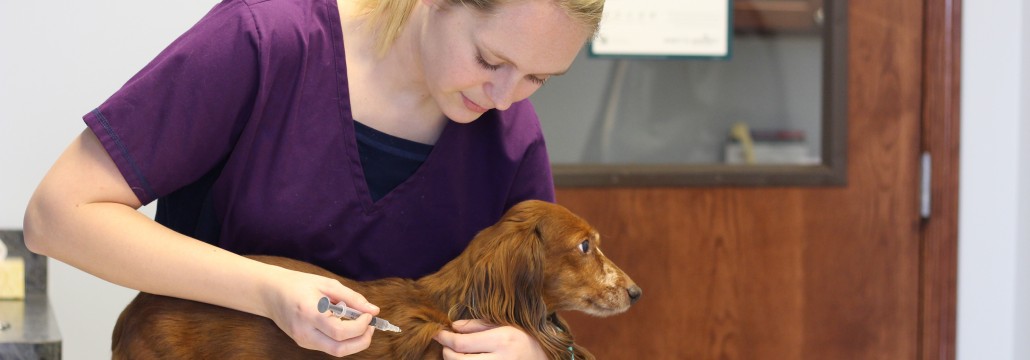Why We Vaccinate!
Dogs and cats are susceptible to many diseases, some lethal, some difficult to treat, and most are debilitating. Vaccines have been developed for many of these diseases for both cats and dogs. While vaccines can protect against certain diseases, none are 100% perfect. Some pets may still become ill after exposure, but a vaccine will often shorten the duration they are sick, or limit how severely ill they become. There has been much controversy with vaccination and “over vaccination” especially regarding children. Some of this misinformation and hype has been translated to the veterinary field. While most pets require some sort of vaccine yearly, certain vaccines can be given on a three-year schedule. This allows us to vaccinate less often but provide the same level of protection. Typically, bacterial diseases require a yearly booster and most viral diseases have three year vaccines. Below is a summary of the diseases and vaccines that are offered at Riverview Veterinary Clinic. Please note, that Dr. Schifo and Dr. Marion will make recommendations on which vaccines and protocols would be best for your pet based on the lifestyle and exposure risk. Vaccines are an integral component of pet wellness and Riverview Veterinary Clinic offers safe, reliable vaccines for your cat and dog.
Dog
Rabies: This is probably the most well-known vaccine because many counties require pets to be vaccinated for this deadly disease. This virus affects many different species of animals, including cats, dogs, and humans. Rabies is spread from an infected animal to another usually by a bite or scratch. The virus travels along the central nervous system then to other organs, causing inflammation. Once neurologic signs are present, the mortality rate is about 90% meaning 9 out of 10 infected patients will die. Luckily there is a vaccine indicated for the protection of rabies that is available for cats and dogs. Once the initial vaccine is given, the following year a 3 year vaccine may be an option. This is considered a core vaccine meaning all dogs and cats should be vaccinated against Rabies.
Distemper: Included in most combination vaccines, distemper is a viral disease that affects dogs and other wild species. This disease causes disease of the nervous system, gastrointestinal system, respiratory system, and parts of the skin. Dogs affected with distemper may display coughing, gagging, nasal and ocular discharge, vomiting, diarrhea, twitching, and or seizures. There is no treatment for distemper and patients that can survive the disease will have both non-life threatening and life-threatening signs throughout the remainder of its life. Typically, dogs will have abnormal thickening of the pads of their feet (non-life threatening). In addition, the damage endured by the nervous system often leads to limited mental abilities, seizures, reduced sight, and stumbling. Like Rabies vaccine, this is considered a core vaccine that all dogs should be protected against.
Adenovirus (Canine Hepatitis): Included with the Distemper Combination vaccines, CAV-1 protects against a viral disease that affects dogs and causes damage to the liver and kidneys. Death associated with CAV-1 is usually due to damage and disease of the liver. Treatment for this disease is supportive and surviving dogs have lasting effects and permanent damage to the liver.
Parvovirus: This highly contagious virus mainly affects dogs, usually young unvaccinated puppies. “Parvo” is a highly lethal disease where mortality rates can reach over 90%. This disease is associated with severe bloody diarrhea, vomiting, lethargy, fever and abdominal pain. The virus causes destruction of the intestinal cells leading to dehydration, loss of electrolytes, and inability to absorb nutrients. Blood and protein loss is also common due to the “leakiness” that occurs with parvovirus infection. In addition, the bacteria normally present in the intestinal tract can leak into the blood stream causing endotoxemia and sepsis. Treatment is supportive for infected dogs and usually consists of intravenous fluids, anti-nausea medications and broad spectrum antibiotics. Severe cases may require blood and/or plasma transfusions. Surviving dogs can remain contagious for several weeks following apparent recovery and the organism is highly resilient and can survive in the environment for long periods of time. This disease is included in the “distemper” combination vaccines and the series begins at 6 weeks of age for most puppies. Prevention through vaccination is the most effective means to protect your dog against parvovirus.
Leptospirosis: Illinois is a Lepto prevalent area, meaning this organism is readily found in the environment. This bacterium is a spiral shaped organism that is absorbed through mucous membranes or ingested. “Lepto” affects many species and each species with varying degrees of illness. Many wildlife species are able to tolerate infection and spread the organism with their urine. Our pets are exposed when they contact this urine in contaminated fields, streams, ponds, and even the backyard. Unfortunately for dogs, infection causes fatal kidney and liver disease and treatment is often unsuccessful. Additionally, since this disease is zoonotic (affects several species) people are at risk from contracting this disease from their pets. There has been some controversy regarding the vaccine for leptospirosis, particularly regarding reactions. While this was more commonly seen in the veterinary field 10-15 years ago, drastic improvements have been made with today’s line of vaccinations. They are safer, cause less reactions, and maintain effectiveness for 1 year duration. Riverview Veterinary Clinic is proud to offer the Ultra line of leptospirosis vaccines by BI that have been purified to lower rates of reactions. These dosages are ½ ml versus the traditional 1.0 ml injection. Most dogs are at risk for Leptospirosis in the area, therefore the doctors will likely recommend this vaccine for your dog.
Lyme Disease: This tick-borne disease is being diagnosed in dogs with increasing frequency. This may be due to newer testing protocols, such as the 4DX heartworm and tick panel that is performed at Riverview Veterinary Clinic, and/or due to spread of infected ticks and increased exposure of our pets. In addition to detecting presence of heartworm infection, the 4DX test will determine if there is proof that your dog has been bitten by a tick, and been infected with several tick-borne diseases, including Lyme Disease. Lyme Disease is caused by a bacterium called Borelia Burgdorfi and this organism is associated with joint swelling and pain as well as damage to the kidneys. Treatment is often difficult and rarely leads to elimination of the organism from the body. Dogs that are exposed to areas where ticks can be found can be vaccinated against this disease. This vaccine is administered annually following the initial booster series.
Bordetella: The disease commonly referred to as “kennel cough” is caused by a bacterial organism called Bordetella. The name kennel cough given to this disease dates back to when it was first identified in kennel situations. In an environment such as a kennel where several dogs are in close confinement, this disease can spread rapidly by oral secretions, directly or indirectly through a contaminated surface. This causes an upper respiratory infection that affects the trachea where dogs have a dry, honking, and non-productive cough. Dogs that are exposed to other dogs, or are in areas where other dogs go are at risk for kennel cough. Places such as grooming facilities, pet stores, dog parks, or any dog-social gathering places risk for your dog. Riverview Veterinary Clinic offers the oral vaccine that is given annually to protect your dogs.
Vaccinations are an important part of canine wellness. They protect against fatal diseases that our beloved are exposed to. They reduce the risk of illness and if infected may shorten the duration and lessen the severity of a disease to increase the chances of survival. Dr. Schifo and Dr. Marion can ensure your pet is protected appropriately and safely during your pet’s wellness examination.




